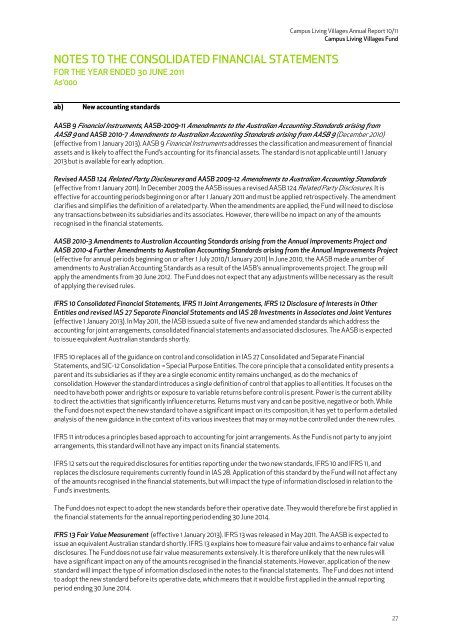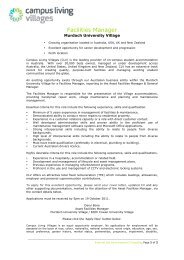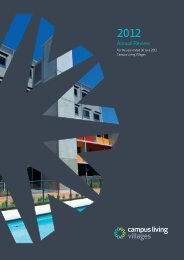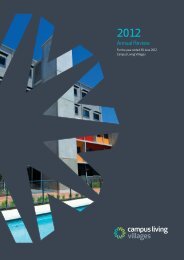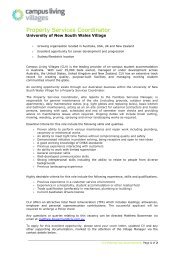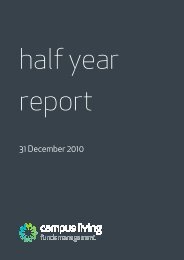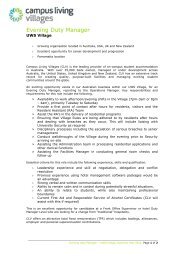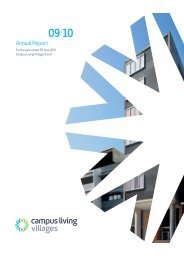Annual Report 10/11 - Campus Living Villages
Annual Report 10/11 - Campus Living Villages
Annual Report 10/11 - Campus Living Villages
Create successful ePaper yourself
Turn your PDF publications into a flip-book with our unique Google optimized e-Paper software.
NOTES TO THE CONSOLIDATED FINANCIAL STATEMENTS<br />
FOR THE YEAR ENDED 30 JUNE 20<strong>11</strong><br />
A$’000<br />
<strong>Campus</strong> <strong>Living</strong> <strong>Villages</strong> <strong>Annual</strong> <strong>Report</strong> <strong>10</strong>/<strong>11</strong><br />
<strong>Campus</strong> <strong>Living</strong> <strong>Villages</strong> Fund<br />
ab)<br />
New accounting standards<br />
AASB 9 Financial Instruments, AASB-2009-<strong>11</strong> Amendments to the Australian Accounting Standards arising from<br />
AASB 9 and AASB 20<strong>10</strong>-7 Amendments to Australian Accounting Standards arising from AASB 9 (December 20<strong>10</strong>)<br />
(effective from 1 January 2013). AASB 9 Financial Instruments addresses the classification and measurement of financial<br />
assets and is likely to affect the Fund’s accounting for its financial assets. The standard is not applicable until 1 January<br />
2013 but is available for early adoption.<br />
Revised AASB 124 Related Party Disclosures and AASB 2009-12 Amendments to Australian Accounting Standards<br />
(effective from 1 January 20<strong>11</strong>). In December 2009 the AASB issues a revised AASB 124 Related Party Disclosures. It is<br />
effective for accounting periods beginning on or after 1 January 20<strong>11</strong> and must be applied retrospectively. The amendment<br />
clarifies and simplifies the definition of a related party. When the amendments are applied, the Fund will need to disclose<br />
any transactions between its subsidiaries and its associates. However, there will be no impact on any of the amounts<br />
recognised in the financial statements.<br />
AASB 20<strong>10</strong>-3 Amendments to Australian Accounting Standards arising from the <strong>Annual</strong> Improvements Project and<br />
AASB 20<strong>10</strong>-4 Further Amendments to Australian Accounting Standards arising from the <strong>Annual</strong> Improvements Project<br />
(effective for annual periods beginning on or after 1 July 20<strong>10</strong>/1 January 20<strong>11</strong>) In June 20<strong>10</strong>, the AASB made a number of<br />
amendments to Australian Accounting Standards as a result of the IASB's annual improvements project. The group will<br />
apply the amendments from 30 June 2012. The Fund does not expect that any adjustments will be necessary as the result<br />
of applying the revised rules.<br />
IFRS <strong>10</strong> Consolidated Financial Statements, IFRS <strong>11</strong> Joint Arrangements, IFRS 12 Disclosure of Interests in Other<br />
Entities and revised IAS 27 Separate Financial Statements and IAS 28 Investments in Associates and Joint Ventures<br />
(effective 1 January 2013). In May 20<strong>11</strong>, the IASB issued a suite of five new and amended standards which address the<br />
accounting for joint arrangements, consolidated financial statements and associated disclosures. The AASB is expected<br />
to issue equivalent Australian standards shortly.<br />
IFRS <strong>10</strong> replaces all of the guidance on control and consolidation in IAS 27 Consolidated and Separate Financial<br />
Statements, and SIC-12 Consolidation -- Special Purpose Entities. The core principle that a consolidated entity presents a<br />
parent and its subsidiaries as if they are a single economic entity remains unchanged, as do the mechanics of<br />
consolidation. However the standard introduces a single definition of control that applies to all entities. It focuses on the<br />
need to have both power and rights or exposure to variable returns before control is present. Power is the current ability<br />
to direct the activities that significantly influence returns. Returns must vary and can be positive, negative or both. While<br />
the Fund does not expect the new standard to have a significant impact on its composition, it has yet to perform a detailed<br />
analysis of the new guidance in the context of its various investees that may or may not be controlled under the new rules.<br />
IFRS <strong>11</strong> introduces a principles based approach to accounting for joint arrangements. As the Fund is not party to any joint<br />
arrangements, this standard will not have any impact on its financial statements.<br />
IFRS 12 sets out the required disclosures for entities reporting under the two new standards, IFRS <strong>10</strong> and IFRS <strong>11</strong>, and<br />
replaces the disclosure requirements currently found in IAS 28. Application of this standard by the Fund will not affect any<br />
of the amounts recognised in the financial statements, but will impact the type of information disclosed in relation to the<br />
Fund’s investments.<br />
The Fund does not expect to adopt the new standards before their operative date. They would therefore be first applied in<br />
the financial statements for the annual reporting period ending 30 June 2014.<br />
IFRS 13 Fair Value Measurement (effective 1 January 2013). IFRS 13 was released in May 20<strong>11</strong>. The AASB is expected to<br />
issue an equivalent Australian standard shortly. IFRS 13 explains how to measure fair value and aims to enhance fair value<br />
disclosures. The Fund does not use fair value measurements extensively. It is therefore unlikely that the new rules will<br />
have a significant impact on any of the amounts recognised in the financial statements. However, application of the new<br />
standard will impact the type of information disclosed in the notes to the financial statements. The Fund does not intend<br />
to adopt the new standard before its operative date, which means that it would be first applied in the annual reporting<br />
period ending 30 June 2014.<br />
27


